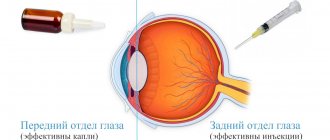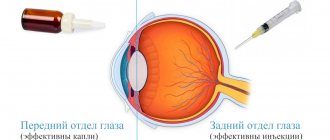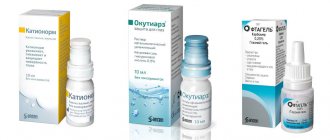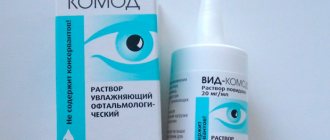Compound
1 ml of Oftalmoferon eye drops contains 10,000 IU of human recombinant interferon alpha-2b , as well as an additional active compound – 1 mg of diphenhydramine hydrochloride ( diphenhydramine ).
Auxiliary are: 3.1 mg of boric acid, 0.4 mg of disodium edetate, 2.2 mg of sodium chloride, 7 mg of sodium acetate, 3 mg of hypromellose, 5 mg of povidone 8000, 50 mg of macrogol 4000 and approximately 1 ml of purified water.
Analogs
Oftalmoferon eye drops have several analogues. They have a similar effect, but may differ in composition and degree of effectiveness:
- Albucid. The drug is especially effective in the treatment of bacterial conjunctivitis. The constituent elements penetrate deep into the eye and prevent the appearance and spread of harmful microorganisms.
- Alfarona. The medicine has an immunomodulatory and antiviral effect. Harmful pathogens develop immunity over time, so using the drug for long-term treatment is not recommended.
- Aktipol. Antiviral medicine. Takes an active part in restoring the damaged membrane of the eyeball. Drops relieve swelling and heal wounds that appear as a result of exposure to microbes.
- Poludan. The speed of penetration into the tissues and membrane of the eye is comparable to Oftalmoferon. The main component is polyriboadenylic acid.
Pharmacodynamics and pharmacokinetics
Ophthalmoferon is a combined drug containing an antiviral immunomodulatory antiproliferative substance - human recombinant interferon α-2b , which is supplemented with an active antihistamine - diphenhydramine .
Diphenhydramine acts by blocking H1-histamine receptors, which has an antiallergic effect, reducing swelling and itching in the human conjunctiva.
Pharmacokinetic properties
If you follow the instructions and apply eye drops topically, then systemic absorption does not occur - the concentration of the active substances of the drug in the blood is achieved significantly less than the standard detection limit (for example, for interferon α-2b - approximately 1-2 IU in 1 ml), which does not allows you to identify clinically significant reactions.
Contraindications and adverse reactions
Eye drops should not be taken if you have a personal intolerance to at least one of the constituent substances. The drug is also contraindicated for people prone to severe allergic reactions.
Usually the drug is well tolerated by patients. But if there is excessive sensitivity to the constituent elements, then adverse reactions may occur in the form of:
- swelling of the eyelids;
- burning sensation in the eye area;
- redness of the eyes;
- blurred vision.
These side effects do not pose a serious threat and disappear very quickly without medical help. You should not refuse to take drops because of this. If after taking the medicine the eyelids begin to swell and a rash appears in the eye area, then you will need to consult a specialist.
No cases of overdose have been identified.
Indications for use
- conjunctivitis of various types, including adenoviral , hemorrhagic ( enteroviral ), herpetic ;
- keratitis - adenoviral , herpetic (card-shaped, vesicular, dotted or tree-like);
- herpetic keratitis with stroma, which may be accompanied by corneal ulceration;
- or herpetic keratoconjunctivitis ;
- herpetic uveitis or keratouveitis (ulceration is possible);
- with dry keratoconjunctivitis (dry eye syndrome);
- prophylactic for graft disease , to prevent relapses of herpetic keratitis after keratoplasty ;
- prevention or treatment of complications after excimer laser refractive surgery on the cornea.
Use during pregnancy and children
Keep in mind! Drops can be taken during pregnancy, but only after specialists have analyzed the reactions of the fetus and mother to the action of the active substances contained in the drug.
In most cases, you can use the product during pregnancy and lactation .
Using the medicine to treat viral diseases in children also does not cause any complications or side effects.
Oftalmoferon eye drops, instructions for use (Method and dosage)
The drug is used conjunctivally until symptoms disappear completely for various eye lesions or for prevention.
For viral diseases
Adults and children in the acute stage are prescribed 1-2 drops to be instilled approximately 6-8 times during the day. When positive dynamics appear and the inflammatory process is stopped, instillation can be reduced to 2-3 times.
For keratoconjunctivitis sicca (dry eye syndrome)
Recommended daily use - 1-2 drops twice a day for 25-30 days.
Instructions for the use of Oftalmoferon for preventive purposes
- Complications after excimer laser refractive surgery on the cornea of the eye: drops should be used daily from the first day of surgery according to the scheme: 1-2 drops. 2 times a day, course – at least 10 days.
- Graft disease or prevention of recurrence of herpetic keratitis that occurs after keratoplasty: the drug should be used daily according to the regimen: 1-2 drops. into the operated eye 3-4 times a day, the course is at least 14 days, starting from the first day after surgery.
Attention! When using contact lenses , drops can be used only after removing the lenses; they can be put on only 15–20 minutes after the instillation procedure.
pharmachologic effect
Ophthalmoferon refers to combination drugs containing immunomodulatory recombinant interferon , the effect of which in the composition of the drug is enhanced by diphenhydramine (an antihistamine drug).
When exposed to these substances, allergic reactions in the form of redness and swelling of the conjunctival membrane are reduced.
Such drops are intended only for topical use, and the absorption of the drug into the blood occurs in such small quantities that its presence is not even diagnosed in the blood.
And, therefore, the active components cannot provoke any serious clinical reactions.
Once in the eye tissue, ophthalmoferon stimulates reparative processes in the cornea, provided that such pathologies are caused by bacteria and viruses.
This includes those accidentally introduced into the organs of vision during surgery or injuries.
Newborns
Since Ophthalmoferon contains interferon and has an immunomodulatory and antiviral effect, it is more preferable for newborns. In addition, it has an antipruritic effect and restores damaged eye tissue, stopping the inflammatory process.
The drug is not contraindicated for newborns, however, before use, the mother should consult an ophthalmologist who, depending on the child’s age and the course of the disease, will determine the dosage and treatment regimen individually.
Pharmacology
Oftalmoferon is a drug of combined action. The composition contains immunomodulatory interferon. Its effects are increased by the presence of diphenhydramine. With the simultaneous influence of these two components, allergic processes manifested in the form of swelling and redness of the conjunctival membrane begin to gradually disappear.
These drops are intended for local use. They are absorbed into the blood in minimal quantities; their presence is even difficult to detect. The active substances cannot cause serious medical consequences.
Oftalmoferon's analogues
Level 4 ATC code matches:
Florenal
Oksolin
Oxolinic ointment
Zirgan
Oftan I'm coming
Poludan
There are known analogues of eye drops that also have antiviral or immunostimulating effects:
- Aktipol
- Poludan
- Oftan-Idu
Prices and analogues
The drug has analogs that have identical effects. These include: Oftan-Ida, Aktipol and Poludan.
Analogues can only be used after consultation with a doctor.
Eye drops in a 10 ml bottle can be purchased for 300-400 rubles (depending on the region). Oftalmoferon is sold in pharmacies without a doctor's prescription.
Shelf life – 24 months, from the moment of opening – 1 month. Store in a dry place, out of direct sunlight and out of reach of children. Storage temperature from 3 to 8 degrees.
Reviews about Oftalmoferon
Today, Oftalmoferon eye drops are quite popular and in demand, reviews and discussions of which can be found on various Internet resources and forums. Most often, the comments are positive, because they can be used both in children and in elderly patients suffering from eye problems - various etiologies of conjunctivitis, “dry eye”, as well as for prevention purposes.
Mothers praise Oftalmoferon, noting its safety of use, availability, lack of itching and allergies.
Can it be taken by newborns?
Since the composition contains interferon and the drug has an antiviral and immunomodulatory effect, it can be given to newborns. In addition, they have an antipruritic effect and promote the regeneration of eye tissue, blocking inflammatory reactions.
Before applying eye drops to a newborn, parents should come for an examination by a specialist who, taking into account the age and condition of the baby, will be able to establish an individual treatment regimen and acceptable dosage.
Oftalmoferon price, where to buy
Many patients like the easy-to-use and affordable Oftalmoferon eye drops, the price of which does not exceed 350 rubles. for 10 ml. The price of eye drops of a smaller volume - 5 ml is usually up to 200 rubles.
- Online pharmacies in RussiaRussia
- Online pharmacies in KazakhstanKazakhstan
ZdravCity
- Oftalmoferon drops hl.
10000 IU/ml 10 ml ZAO Firn M 355 rub. order
Pharmacy Dialogue
- Ophthalmoferon (vial 10 ml eye/drop) Firn M
RUB 310 order
show more
Ingredients and release form
Drops are produced in sterile bottles of 5 and 10 ml. The active ingredients are:
- recombinant interferon. Has an antiviral effect and local immunostimulating effect;
- Diphenhydramine Has antiallergic, analgesic and anti-inflammatory effects;
- boric acid. It has an analgesic effect;
- "artificial tear" Performs a protective function and prolongs the effect of the drug.
The constituent components enhance the effect of the medicine.
Reviews from parents
Anna: My daughter goes to kindergarten - she either rubs her eyes with dirty hands, or puts a soft toy to them. Very often we develop conjunctivitis and the eye becomes sour. The doctor prescribed Oftalmoferon and Tobrex, improvements came on the third day. I have been using antiviral drops for up to a month, as a result the disease has begun to appear less frequently. I didn't notice any side effects.
Anton: After birth, my son’s eyes often festered; doctors tried not to prescribe antibacterial drugs. The pharmacy recommended Oftalmoferon - safe and effective. The only drawback is the need to store in the refrigerator.
Reviews from doctors
Oleg Gennadievich, ophthalmologist: In pediatric practice for conjunctivitis, I often prescribe Oftalmoferon in combination with antibacterial drops and eye ointment. This scheme helps very quickly and well; before use, you need to rinse your eyes with green tea or chamomile decoction. The advantages of the drug are that there are no age restrictions or side effects.
Olga Sergeevna, ophthalmologist: For adults and children with viral eye diseases, I prescribe safe Russian drops Oftalmoferon. The only drawback is the relatively high price. The medicine is well tolerated at any age and can be combined with all types of other eye drops.






